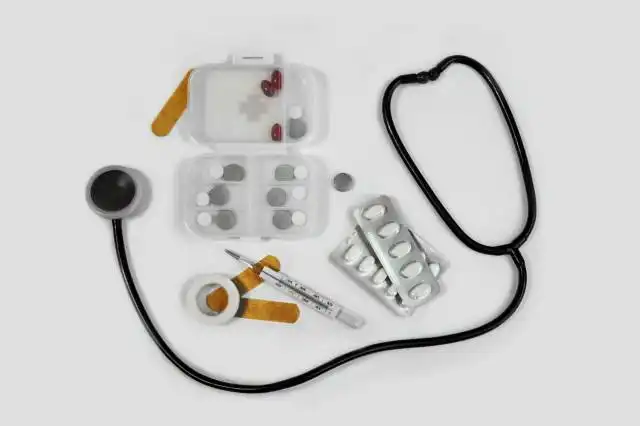Start a Pharmacy
Becoming a Neighborhood Health Superhero: Your Own Pharmacy Journey
| Updated


PHARMACY
So, you're considering opening the door to the world of medicine with your own pharmacy? Entertaining idea! Running a pharmacy business is not just about doing a spocky prescription dance, it's also about creating reliable health transactions with your community. This business provides prescription medications, health consultations, and over-the-counter drugs to customers, making you a neighborhood health superhero with a white coat instead of a cape!
Jump to Business Plan
RELATED BUSINESS IDEAS
Browse ALL Health & Beauty Innovations Business Ideas
Discover Your Perfect Domain
Unlock the door to your online success with our hand-picked selection of premium domain names. Whether you're starting a new venture or rebranding an existing one, the right domain can set the tone for your digital presence. Browse through our curated list, each with its unique potential to enhance your brand's visibility and credibility.
PHARMACY MINI BUSINESS PLAN
This a quick reality check to help you identify the strengths and weaknesses of your business concept before you dive in.
Business Idea: Pharmacy
Expected Percent Margin:
- Gross Margin: 20-30%
- Net Profit Margin: 3-5%
Earnings Expectations:
- Daily Earnings: $500 - $1500
- Weekly Earnings: $3,500 - $10,500
- Monthly Earnings: $15,000 - $45,000
- Annual Earnings: $180,000 - $540,000
Actions to Hit Those Numbers:
Inventory Management:
- Initial Investment: Around $100,000 for standard pharmaceutical inventory.
- Supplier Network: Establish relationships with main pharmaceutical distributors.
Marketing and Customer Acquisition:
- Social Media: Regular updates about pharmacy services and health awareness.
- Local Advertising: Collaborate with local clinics and hospitals to refer patients to your pharmacy.
Sales and Customer Experience:
- Staffing: Employ accredited pharmacists and friendly, knowledgeable assistants.
- Customer Service: Provide personalized, attentive customer service, including medication counselings and health advice.
Cost Control:
- Rent: Choose a location where rent is less than 10% of expected monthly sales.
- Utilities & Maintenance: Budget should be around $1000-$2000 per month.
Business Operations:
- Open Hours: Open at least 6 days a week, 8-10 hours a day.
- Transaction Volume: Aim for 50-100 transactions per day at an average sale price of $10-$30.
Please remember these are averages, success can vary by location, competition, and execution and these figures are rough estimates. Always consult a financial advisor for personalized advice.
NOT WHAT YOU HAD IN MIND? Here are more ideas



Browse ALL Health & Beauty Innovations Business Ideas
Grab Your Business Website Name
Before you get caught up in the whirlwind of setting up your business, invest in a domain name. It's a small but significant step that lays the foundation for your brand and makes it easier for customers to find and trust you. Just like you wouldn't build a house without securing the land first, don't build a business without securing your domain name.
"Why? Can't that wait?" Here's why it shouldn't
Step 1: Determine if Starting a Pharmacy is Right for You
Breakdown of Startup Expenses
Starting a pharmacy requires a significant investment of capital. Before making the decision to open a pharmacy, it is important to understand the startup costs associated with the endeavor. These costs can include the cost of the building, renovations, equipment, inventory, and licenses. Additionally, it is important to consider the cost of hiring qualified staff and the cost of advertising and marketing.
Breakdown of Ongoing Expenses
In addition to the startup costs, it is important to consider the ongoing expenses associated with running a pharmacy. These expenses can include the cost of rent, utilities, insurance, payroll, inventory, and taxes. Additionally, it is important to consider the cost of any necessary repairs and maintenance, as well as the cost of any necessary upgrades to the facility or equipment.
Examples of Ways to Make Money
There are a variety of ways to make money with a pharmacy. These include selling prescription medications, over-the-counter medications, and health and beauty products. Additionally, pharmacies can offer services such as vaccinations, medical advice, and medical testing. Finally, pharmacies can offer additional services such as home delivery, online ordering, and loyalty programs.
Step 2: Name the Business
Brainstorm ideas: Brainstorming is an important part of the process when it comes to naming a business. Consider the type of business, the target audience, and the overall message you want to convey. Brainstorming can be done alone or with a group of people.
Consider the domain name: When it comes to naming a business, the domain name is just as important as the business name itself. It’s important to consider the domain name when brainstorming ideas because it can be difficult to find an available domain name that matches the business name.
Check for trademark infringement: Once you have a few ideas, it’s important to check for trademark infringement. This can be done by searching the United States Patent and Trademark Office (USPTO) database. If the name is already trademarked, it’s best to move on and find another name.
Get feedback: Once you have a few potential names, it’s important to get feedback from friends, family, and potential customers. This can help you narrow down your list and make sure the name is something people can easily remember and identify with.
Make sure the name is memorable: The name of your business should be memorable and easy to pronounce. It should also be something that reflects the values of the business and resonates with your target audience.
Step 3: Obtain Licenses and Permits
In order to open a pharmacy, there are certain licenses and permits that must be obtained. Depending on the state, these may include a pharmacy license, a controlled substance registration, a business license, and a tax permit. It is important to research the specific requirements for the state in which the pharmacy will be located. Additionally, the pharmacy must be registered with the Drug Enforcement Administration (DEA) in order to handle controlled substances.
Cost of Licenses and Permits
The cost of licenses and permits varies depending on the state and the type of license or permit. For example, a pharmacy license in California costs $1,500, while a business license in New York costs $100. Additionally, there may be additional fees associated with the application process. It is important to research the cost of licenses and permits before starting the application process.
Application Process
The application process for licenses and permits can be lengthy and complex. It is important to understand the requirements and complete all necessary paperwork. Additionally, it is important to be aware of any deadlines associated with the application process. The application process can take several weeks or months, so it is important to plan accordingly.
Other Considerations
In addition to obtaining the necessary licenses and permits, it is important to understand the regulations and laws associated with operating a pharmacy. This includes understanding the requirements for labeling and storing medications, as well as the requirements for handling controlled substances. Additionally, it is important to understand the laws and regulations related to the sale of over-the-counter medications. Understanding these regulations is essential for operating a pharmacy in a safe and compliant manner.
Step 4: Find a Location
Accessibility When choosing a location for a pharmacy, it is important to consider how accessible it is to customers. Accessibility can be determined by the proximity of the pharmacy to public transportation, parking availability, and the presence of other businesses in the area. It is important to consider the demographics of the area and the types of customers that will be using the pharmacy. Additionally, it is important to consider the zoning laws of the area and whether the pharmacy will need to obtain a special permit to operate.
Security Security is another important factor to consider when choosing a location for a pharmacy. It is important to make sure that the pharmacy is located in a safe area with minimal crime. Additionally, it is important to consider the security of the building itself. The pharmacy should have a secure entrance and exits, as well as a security system to protect the products and customers.
Cost The cost of the location is also an important factor to consider when choosing a location for a pharmacy. It is important to compare the costs of different locations and to make sure that the cost is within the budget of the pharmacy. Additionally, it is important to consider the cost of utilities, taxes, and insurance for the location.
Size The size of the location is also an important factor to consider when choosing a location for a pharmacy. It is important to make sure that the pharmacy has enough space to accommodate the products, customers, and staff. Additionally, it is important to make sure that the pharmacy has enough space for any future expansion.
Visibility Visibility is another important factor to consider when choosing a location for a pharmacy. It is important to make sure that the pharmacy is visible from the street and that it is easy to find. Additionally, it is important to consider the signage for the pharmacy and how it will be seen by potential customers.
Step 5: Purchase Equipment and Supplies
When starting a pharmacy, there are a variety of equipment and supplies that must be purchased in order to get the business up and running. This includes items such as a cash register, computer, printer, and other office equipment. Additionally, the pharmacy must have a variety of medical supplies, such as syringes, bandages, and other medical products. It is important to research the different types of equipment and supplies needed in order to ensure that the pharmacy is properly stocked and able to provide the necessary services to customers.
Where to Purchase Equipment and Supplies
When purchasing equipment and supplies for a pharmacy, it is important to find the best deals and prices. This can be done by researching different suppliers and comparing prices. Additionally, it is important to consider the quality of the equipment and supplies, as this will determine how long they will last and how well they will perform. It is also important to consider the delivery time of the equipment and supplies, as this will determine how quickly the pharmacy can open its doors and start providing services.
Cost of Equipment and Supplies
The cost of the equipment and supplies needed to open a pharmacy can vary greatly depending on the types of items purchased. It is important to research the different prices and compare them in order to ensure that the best deal is found. Additionally, it is important to factor in the cost of delivery and installation, as these costs can add up quickly. It is also important to consider any warranties or guarantees that may be offered with the purchase of the equipment and supplies, as this can help to protect the business in the event of any issues or malfunctions.
Step 6: Hire Employees
When hiring employees for a pharmacy, it is important to ensure that they have the necessary qualifications and skills. Pharmacists should have a Doctor of Pharmacy degree, and should be licensed in the state in which the pharmacy is located. Pharmacy technicians should have a high school diploma or equivalent, and should have completed a pharmacy technician certification program. Additionally, all employees should have excellent customer service skills, as well as the ability to work in a fast-paced environment.
Where to Find Employees
When looking for employees, it is important to use a variety of resources. Posting job openings on job boards, such as Indeed or Monster, is a great way to reach a large pool of potential applicants. Additionally, it is important to reach out to local colleges and universities, as they may have students who are looking for part-time or full-time work. Finally, it is important to network with other local businesses, as they may have employees who are looking for a new job opportunity.
Interview Process
Once potential employees have been identified, it is important to have an organized and thorough interview process. During the interview, it is important to ask questions that will help determine if the applicant is a good fit for the job. Questions should focus on the applicant’s qualifications, experience, and customer service skills. Additionally, it is important to ask questions that will help determine if the applicant is a team player and is able to work well with others. After the interview, it is important to check references and to make sure that the applicant is legally allowed to work in the United States.
Step 7: Market Your Business
Once you have your business up and running, you will need to market it to potential customers. There are a variety of ways to market your business, including online advertising, social media, print advertising, and word-of-mouth. Online advertising is a great way to reach a large audience quickly and cost-effectively. You can use search engine optimization (SEO) to ensure that your website appears at the top of search engine results. Social media is also a great way to reach potential customers. You can create a business page on popular social media sites such as Facebook and Twitter, and use it to post updates about your business, special offers, and other information. Print advertising is also an effective way to reach potential customers. You can place ads in local newspapers and magazines, or even create your own flyers and distribute them in your local area. Word-of-mouth is also a great way to market your business. Ask your friends and family to spread the word about your business, and offer incentives such as discounts or free products for referrals.
Step 8: Obtain Necessary Licenses and Permits
Research Licensing Requirements
Before you can open your pharmacy, you will need to obtain the necessary licenses and permits. The licensing requirements vary from state to state, so it is important to research the requirements in your state. You will need to apply for a pharmacy license, as well as any other licenses or permits that may be required. You may also need to obtain a business license, a sales tax permit, and a zoning permit. Once you have obtained all of the necessary licenses and permits, you will be ready to open your pharmacy.
Step 9: Open Your Business
Hire Employees
Once you have obtained all of the necessary licenses and permits, you will be ready to open your business. You will need to hire employees to help you run the pharmacy. Make sure to hire employees who have the necessary qualifications and experience. You will also need to purchase the necessary equipment and supplies for your pharmacy. This includes items such as computers, scales, and medical supplies. Once you have everything in place, you will be ready to open your pharmacy and start serving customers.
Step 8: Set Up Accounting and Bookkeeping Systems
When starting a pharmacy, it is important to set up an accounting and bookkeeping system. This system will help to keep track of all financial transactions and provide an accurate record of the business’s financial health. There are many different types of accounting and bookkeeping systems available, including cash-basis accounting, accrual-basis accounting, and double-entry bookkeeping. Cash-basis accounting is the simplest type of accounting system and is best suited for small businesses. Accrual-basis accounting is more complex and is best suited for larger businesses. Double-entry bookkeeping is the most complex accounting system and is best suited for businesses that have a large number of transactions.
Benefits of Accounting and Bookkeeping Systems
Having an accounting and bookkeeping system in place is essential for any business, and a pharmacy is no exception. An accounting and bookkeeping system will help to ensure that all financial transactions are recorded accurately and that the business’s financial health is monitored on a regular basis. Additionally, having an accounting and bookkeeping system in place will help to ensure that the business is compliant with all applicable laws and regulations. Finally, having an accounting and bookkeeping system in place will help to ensure that the business is able to make informed decisions about its financial future.
Step 9: Set Up an Online Presence
Setting up an online presence for your pharmacy business can be a great way to reach more customers and increase sales. An online presence can help you to create a professional image for your business, as well as make it easier for customers to find you. Additionally, having an online presence can help to increase your visibility and credibility in the industry.
Steps for Setting Up an Online Presence
The first step in setting up an online presence is to create a website for your pharmacy. This website should include information about your business, such as your services, products, and contact information. Additionally, you should include a blog section on your website to provide customers with helpful information about your pharmacy and the industry.
Once you have created your website, the next step is to create social media accounts for your business. This will allow you to engage with customers and potential customers, as well as promote your business. You should also create accounts on review sites such as Yelp and Google My Business, as this will help to increase your visibility and credibility.
The last step in setting up an online presence is to create an email list. This will allow you to send out newsletters and other promotional materials to your customers. Additionally, you can use this list to send out surveys and other feedback forms to your customers to help you improve your services.
Overall, setting up an online presence for your pharmacy business can be a great way to reach more customers and increase sales. By creating a website, social media accounts, and an email list, you can create a professional image for your business and increase your visibility and credibility in the industry.
EXPLORE MORE CATEGORIES
Browse ALL Business Idea Categories
TAKE THE NEXT STEPS










